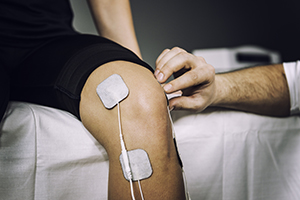TENS Therapy
TENS Therapy
Healthcare providers have been using electricity to help relieve pain since the mid-1960s. This form of pain relief sends electricity directly to parts of the body. It's called transcutaneous electrical nerve stimulation, or TENS. A growing body of research says that TENS therapy may help some people in the right situation.
Understanding nerve stimulation therapy
The main reason that people use electric nerve stimulation therapy is to ease pain. Some of the common conditions that cause pain and may be helped by TENS include arthritis, tendonitis, bursitis, surgery, migraines or other headaches, wounds, and injuries. Some experts believe electric nerve stimulation therapy has the greatest use for treating nerve pain.
Nerve stimulation therapy delivers mild electrical impulses to the body. The system is made up of a power unit, a pair of wires, and electrode pads that are placed on your skin near the place that hurts. A practitioner or patient turns on the unit, and low-voltage electrical current flows into the body.
TENS sessions usually last 5 to 15 minutes. They can be done as often as needed, depending on the case. Physical therapists and healthcare providers often give TENS. Healthcare providers also can prescribe certain units to use at home. People often say they feel a mild tingling sensation or warmth during the treatments. The tingling sensation may temporarily prevent the person from being aware of pain.
Research on electric nerve stimulation
Hundreds of studies have been done on electric nerve stimulation, but most have been small or weren't well designed. For this reason, some experts say TENS can give short-term relief. Long-term relief hasn't been proved.
More research is needed to know if TENS can help many kinds of acute or chronic pain.
For cancer pain, more research is needed before TENS can be recommended as a treatment for cancer pain. TENS may give short-term relief for some nerve-related cancer pain, according to the American Cancer Society.
The safety of electric nerve stimulation
Electric nerve stimulation is generally regarded as safe. But it has risks just like any other medical procedure. For example, if the electrical current is too high or the electrodes are placed on the wrong part of the body, this can burn or irritate the skin. The "danger zones" include the brain, heart, eyes, and throat. In addition, people with heart problems, pregnancy, or implanted devices, including infusion pumps, pacemakers, and defibrillators, should not get this treatment.
Updated:
February 14, 2018
Sources:
Priyanka, S., Complementary and Alternative Medicine in Cancer Pain Management : A Systematic Review, Indian Journal of Paliative Care (2015); 21(1); 105-115, Subacute and Chronic Low Back Pain: Pharmacologic and Noninterventional Treatment. UpToDate
Reviewed By:
Images Reviewed by Staywell medical art team.,Moe, Jimmy, MD,Taylor, Wanda, L., RN, PhD
